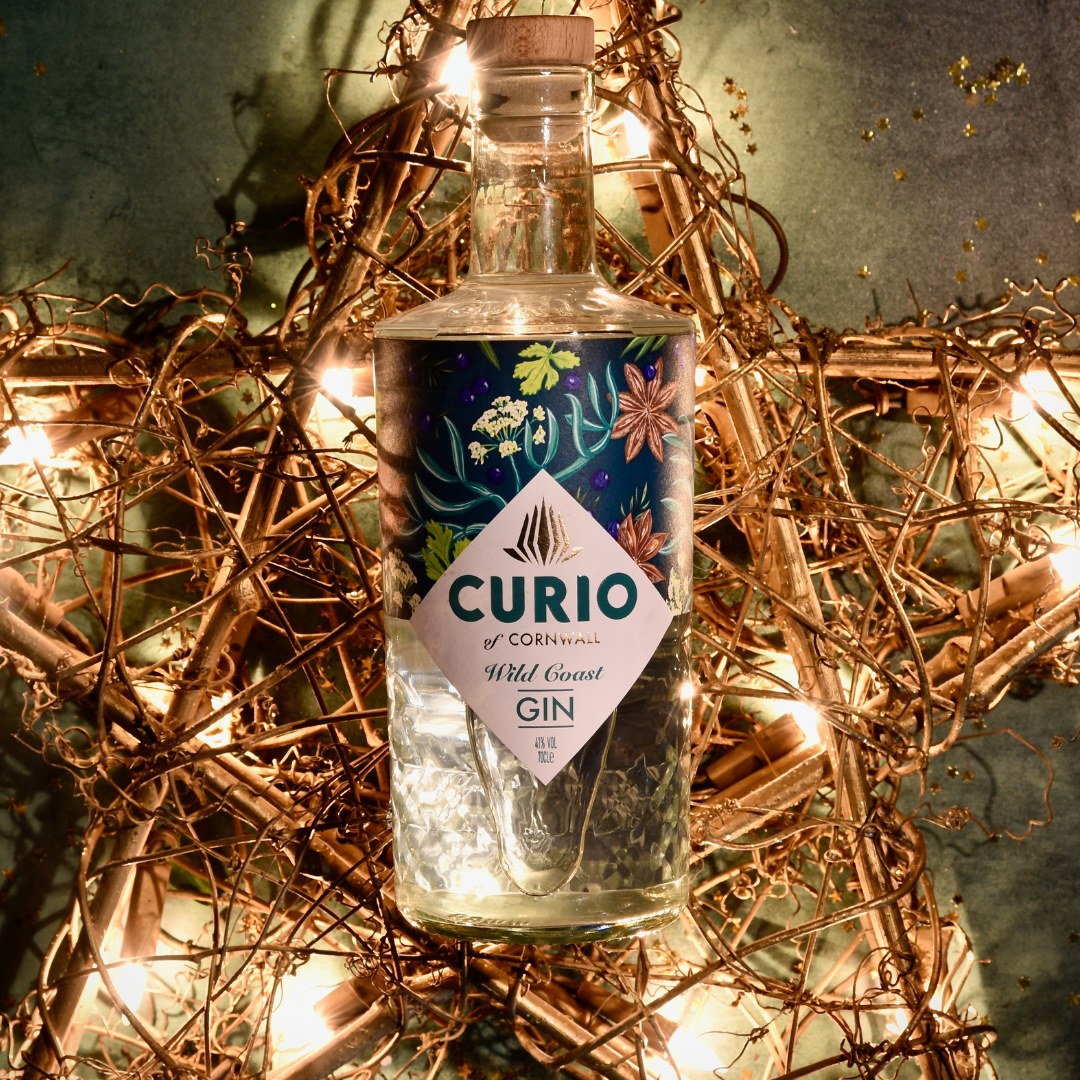
Wiltshire, UK
Asian Parsnip Ltd Freshford House Redcliffe Way Bristol BS1 6NL United Kingdom

James Fine Gin Authentic Small Batch

SB meets… James May, James Gin
19 APRIL 2024 By Rupert Hohwieler
Known for his cars and his worldly TV shows, his dry, English sense of humour and now his dry gin, James May didn’t enter the spirits industry with grand goals – he just wanted to make a nice gin.
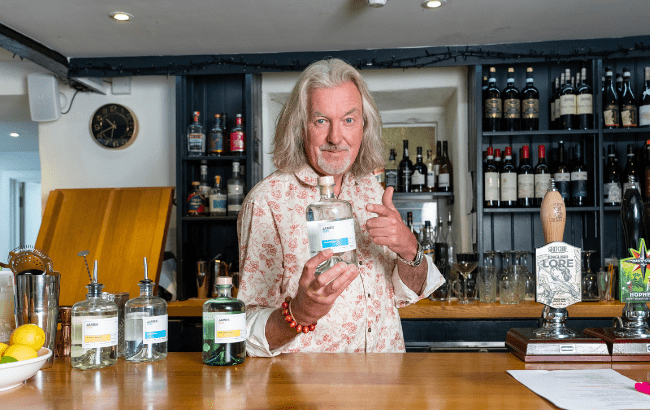
He’s since delivered on that and more, and we caught up with the presenter, journalist and now ‘drinks expert’ about his brand.
Where did the idea to make a gin stem from?
Well, our ambitions weren’t that massive. We didn’t decide to start a gin brand, we just thought we’d have a go at making gin for a bit of a laugh. We had a day at Plymouth Gin, just mucking around with a little still on a benchtop, adding botanicals and learning, and we made several samples. One of them tasted quite nice and from there I thought I’d like to have a go myself.
When I was in a bit of a fallow period with work, I went to see a distiller I’d met [Hugh Anderson of Downton Distillery] near my cottage in Wiltshire. We came up with the idea of Asian Parsnip, which he bottled and sold at gin and drink fairs he attended, and it sold out. Now we’ve got to that difficult place where we’re not a hobby anymore, but we’re not a serious commercial enterprise either. We’re in the artisanal bracket, which is a bit nauseating really, but that’s that’s how it happened – it just happened.
Do you consider yourself a big gin drinker? Why gin?
I’m not as big as Richard Hammond [May’s co-star on Top Gear and The Grand Tour], who drinks gin like I drink tea – but I do drink gin pretty regularly. It’s the spirit I drink the most. I’m a bit boring about this because I tend to have a gin and tonic. I’ve loved gin and tonics since I was a teenager.
As for gin, it’s a great spirit for mucking about and experimenting with, since it is essentially re-rectified vodka. You can come up with different flavours and different subtleties, and try different botanicals. If you made whisky you’d have to leave it for the bloody years before you can sell it (and we’re too old for that), so gin sort of selected itself.
Would you be interested in making a non-alcoholic ‘spirit’?
We talked about it and I know they’re very fashionable, but I can’t really see the point of a non-alcoholic beer or a non-alcoholic ‘gin’. I’ve tried some non-alcoholic ‘gins’ and to me they taste like cordial, which in that case, I’ll just have cordial. Why is it a trend? Has everyone suddenly become terrified of being an alcoholic?
Can’t you just have tonic water with a little bit of elderflower cordial in it? If they do taste like the real thing, then they taste like a very old gin – and that’s coming from someone who makes pretty old gin.
What’s your target demographic?
People aged, very roughly speaking I’d say, 35 or above. I don’t really get the impression that that many of ‘da kids’ are drinking gin. Or they may just not be drinking mine because it’s still quite expensive – despite our recent price drop…
If you could pick a favourite from the range?
If I had to choose, I think London Drizzle is the most radical, but Asian Parsnip is the easiest to drink. It really does work as an idea, which slightly surprised me – I thought it might taste like one of those things where you say ‘oh, that’s interesting’ and then never open it again, like the bottle of limoncello at the back of the cupboard. People do come back and keep buying it. We get quite a few repeat customers, so that’s encouraging.
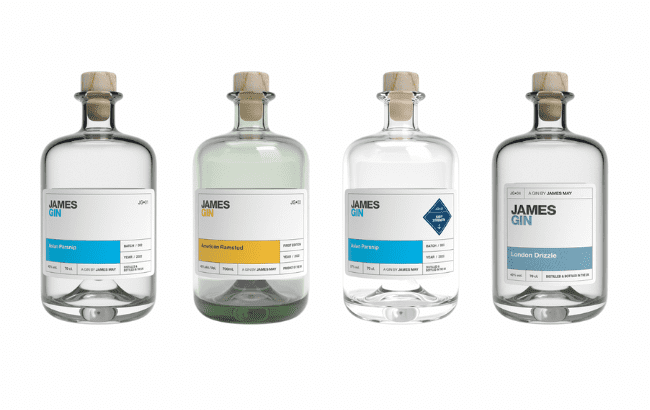
What’s surprised you about the whole gin-making process?
I’m surprised by some of the things that can go into a gin – for example, oyster shells. I suppose oysters are quite distinctive, so the shell does have a bit of a bit of flavour in it, and weirdly it’s one of the few things you can put in gin that stops it from being vegan, because, you know, oysters are alive. Add to that things like wood chips, patchouli oil and beetroot (which we have in one of ours). I think you can probably put just about anything organic in the gin, but whether or not that will work is another story.
How are you faring in the on-trade?
It’s quite difficult. I did talk to Fullers once, but they have quotas for gin. They have their own beer and their affiliated wines, and then gin producers with whom they have done some sort of deal. So they won’t just take another gin on because they have existing laws here. It’s at free houses like my pub, and my local actually has it too because the landlord is allowed a certain amount of latitude with what he buys in. It’s quite difficult to break into pubs and indeed, supermarkets. Our next target is London bars, but the one we’d really love would be the miniatures on a big airline. That would be great but also it’s fiercely competitive.
Are you satisfied with how everything has played out so far?
We did it to have a world of fun, make a gin and make an entertaining little YouTube film. Then I realised it’s a bit more serious than that, and we’d actually managed to come up with something pretty good. I suppose we have to try and slightly break out of the obscure craft gin mould. We’re doing a few things at the moment. We’ve had the bottle redesigned, the labels are going to be much better quite soon, and we’ve got a new flavour coming out at some point later this year.
If it got really popular, it would then be too much for us to deal with, we’d have to pass it over and then it wouldn’t be ours anymore. I’m the world’s worst businessman. That the gin survives, I think, is almost enough reward. It’s a bit like making a slightly niche TV programme.
If the people who do watch it like it, that’s more important to me than millions of people watching it and thinking ‘huh’. It’s a nice feeling that somewhere in, let’s say, Southern California, there’s a man and woman on the porch enjoying a sundowner with a gin that came out of a shed in Wiltshire. That’s what makes it worth it.
Asian Parsnip Gin
Sweet ● Parsnip ● SpicySale
price €40,33

There is no such thing as an ‘Asian parsnip’. Parsnips do not grow in Asia, and are unknown in that region’s culinary canon. Rather, this gin combines the homely flavour of that most English of root vegetables with the gastric stimulus of spices from India. It is a comfort and a thrill in equal measure, and is officially acknowledged as a vital component of UK multi-culturalism.
40% ABV
Hugh’s Tasting Notes
Parsnip, a humble vegetable valued by Romans and hated by schoolchildren – was used historically as a sweetener and has a uniquely nutty profile.
Combined with spices of the Far East – ginger and green cardamom – Asian Parsnip is a warming gin with lingering light sweet notes.
Serving Suggestion
The Tiberius Sour
Emperor Tiberius accepted part of the tribute payable to Rome by Germania in the form of parsnips. He may have celebrated with this – possibly:
- 2 ounces of sugar syrup/agave syrup
- 2 cardamom pods
- 1 ounce freshly squeezed lime juice
- 25ml Lillet Blanc
- 50ml Asian Parsnip and 5 mint leaves
- Garnish with 1 or 2 extra mint leaves

Ingredients
Parsnips: Emperor Tiberius accepted part of the tribute payable to Rome by Germania in the form of parsnips. For the purposes of buying my gin, parsnips should not be considered a currency.
Ginger: Although used in traditional medicine and as a dietary supplement, there is no good evidence that consuming ginger or its extracts has any beneficial effect on human health. But just in case it does, it’s in the gin.
Caraway Seed: Finland supplies about 28% of the world’s caraway seed. Also, many of the best racing drivers. This is because the word ‘car’ appears in both job descriptions.
Cubeb Pepper: In the Chinese Tang dynasty, physicians administered cubeb pepper to restore appetite, cure “demon vapors”, darken the hair, and perfume the body. My gin will also do all of these things, possibly. Let us know how you get on and send photographs.
Fenugreek: Desiccated fenugreek seeds have been recovered from the tomb of Tutankhamun. He was also quite desiccated, so these seeds are of more use in gin than in the afterlife.
Cardamom: There are two main types of cardamom – green and black. My gin contains one of them. Guess which.
Grains of Paradise: John Russell characterized grains of paradise in The Boke of Nurture (1460) as “hot and moist”. Use that information as you wish.
Liquorice Root: The English common name is spelled “liquorice” in most of the Commonwealth but “licorice” in the United States. This is because Americans can’t spell.
Sweet Orange: Since you asked, the color was named after the fruit in about 1512.
Juniper: Gin must contain juniper, or it isn’t gin. In fact, the name ‘gin’ is a shortening of the Dutch word for juniper, ‘jenever’. Not to be confused with ‘Geneva’, which is both a place and a convention but not a drink.
Angelica Root: Angelica Root was also the name of a famous 1920s blues singer from the Mississippi region. Here, it’s botanical.
Coriander Seed: Some people are genetically indisposed towards coriander and believe it tastes of soap. They’re just weirdos, so it’s in the gin.
Water: Asian Parsnip gin is diluted to 40% ABV (or 57% for Navy Strength) by adding water. Because we appreciate the work of 19th-century civil engineers, we use tap water, not hand-drawn Highland Spring or Wiltshire chalk stream water, because it wouldn’t be as good.

Asian Parsnip Navy Strength
Sweet ● Spiced ● IntenseSale
price €59,50

This gin, unsurprisingly, is exactly the same as our regular Asian Parsnip, but stronger (57% ABV versus 40%). It is also more expensive, thanks almost entirely to an increase in duty payable to our government, who will waste it on fripperies such as educational initiatives and improved transport infrastructure. On the other hand, it is more ‘effective’ than regular gin, so less of it is needed, making its consumption a cost-neutral fiscal event. Excessive use may have an effect ear-lie in the mooooorning.
Hugh’s Tasting Notes
Every gin needs a good naval counterpart, and Asian parsnip is no exception. We tested various versions in James’ pub, with feedback gathered from the patrons. The flavour profile is the same as Asian Parsnip, just more intense.
Serving Suggestion
The Corpse Reviver
For something with an extra kick, try the Corpse Reviver. Fresh & full of citrus, this is a great one to relax with.
Simply rinse a glass with some absinthe, then mix all of the following ingredients together:
- 3/4 ounces of Asian Parsnip Navy Strength
- 3/4 ounces of Lillet Blanc
- 3/4 ounces of Orange liquer
- 3/4 ounces of freshly squeezed lemon juice.
Shake and pour.
Ingredients
Parsnips: Emperor Tiberius accepted part of the tribute payable to Rome by Germania in the form of parsnips. For the purposes of buying my gin, parsnips should not be considered a currency.
Ginger: Although used in traditional medicine and as a dietary supplement, there is no good evidence that consuming ginger or its extracts has any beneficial effect on human health. But just in case it does, it’s in the gin.
Caraway Seed: Finland supplies about 28% of the world’s caraway seed. Also, many of the best racing drivers. This is because the word ‘car’ appears in both job descriptions.
Cubeb Pepper: In the Chinese Tang dynasty, physicians administered cubeb pepper to restore appetite, cure “demon vapours”, darken the hair, and perfume the body. My gin will also do all of these things, possibly. Let us know how you get on and send photographs.
Fenugreek: Desiccated fenugreek seeds have been recovered from the tomb of Tutankhamun. He was also quite desiccated, so these seeds are of more use in gin than in the afterlife.
Cardamom: There are two main types of cardamom – green and black. My gin contains one of them. Guess which.
Grains of Paradise: John Russell characterized grains of paradise in The Boke of Nurture (1460) as “hot and moist”. Use that information as you wish.
Liquorice Root: The English common name is spelled “liquorice” in most of the Commonwealth but “licorice” in the United States. This is because Americans can’t spell.
Sweet Orange: Since you asked, the colour was named after the fruit in about 1512.
Juniper: Gin must contain juniper, or it isn’t gin. In fact, the name ‘gin’ is a shortening of the Dutch word for juniper, ‘jenever’. Not to be confused with ‘Geneva’, which is both a place and a convention but not a drink.
Angelica Root: Angelica Root was also the name of a famous 1920s blues singer from the Mississippi region. Here, it’s botanical.
Coriander Seed: Some people are genetically indisposed towards coriander and believe it tastes of soap. They’re just weirdos, so it’s in the gin.
Water: Navy Strength Asian Parsnip gin is diluted to 57% ABV by adding water. Because we appreciate the work of 19th-century civil engineers, we use tap water, not hand-drawn Highland Spring or Wiltshire chalk stream water, because it wouldn’t be as good.
“What a flavorful Gin. One would think that the English gentleman loves on meat and potatoes but this is proof they hide the good stuff. Not that meat and potatoes are wrong, it just gets a little boring with time. This gin is tasty by itself. I often drink it as is after chilling it a little.”
 Play video
Play video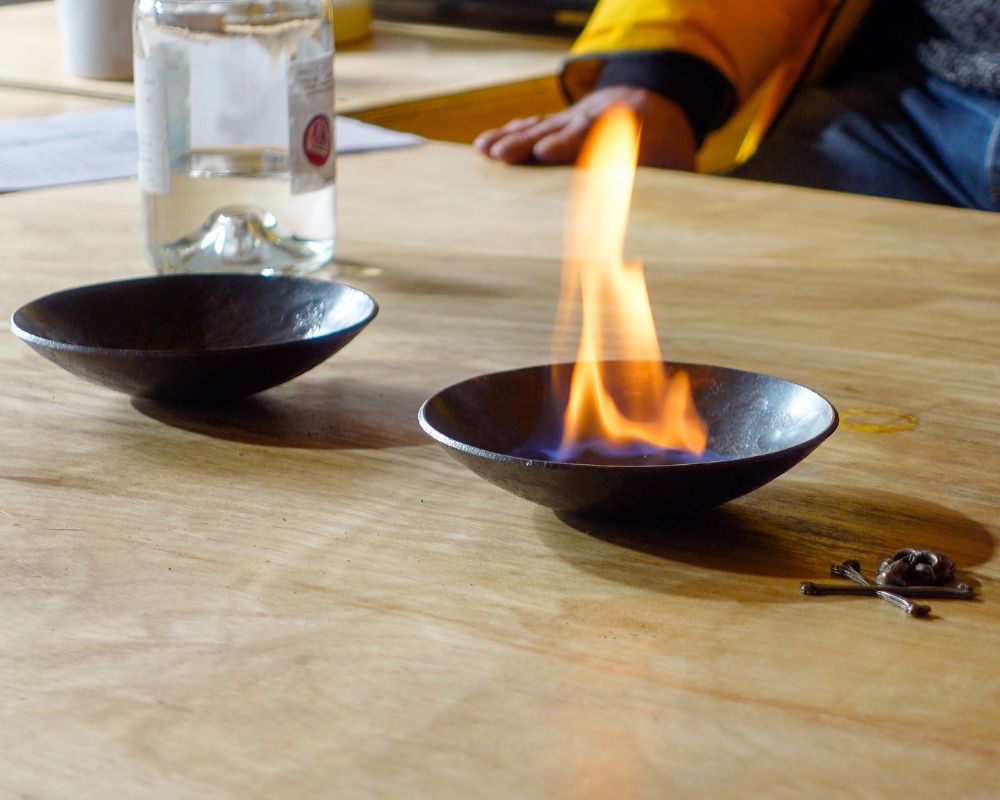




London Drizzle Gin
Umami ● Beetroot ● Majesty
Sale price €40,33Save €9,08


All foreigners think it rains constantly in England, so we thought we’d turn that belief into a distilling and marketing opportunity with a gin that invokes the assault on the olfactory senses that we experience when we open the front doors of our already damp houses and breath in the heady scent of freshly wetted pavement. It may not rain at all where you live, but this pours beautifully. We are famous for our humour.
40% ABV
Hugh’s Tasting Notes
We’ve combined beetroot with lovage, bay, orange, and ginger to create a gin with light notes alongside earthy tones that give an almost umami quality to the gin – and instantly invoke the majesty of our Sceptered Isle.
Serving Suggestion
London Drizzle Beet
- 50ml London Drizzle
- 50ml Beetroot Juice
- 25ml Apple Juice
- 25ml Sugar Syrup
Combine and shake over ice and double strain into a chilled martini glass.
Ingredients
Juniper: Gin must contain juniper, or it isn’t gin. In fact, the name ‘gin’ is a shortening of the Dutch word for juniper, ‘jenever’. Not to be confused with ‘Geneva’, which is both a place and a convention but not a drink.
Coriander Seeds: Some people are genetically indisposed towards coriander and believe it tastes of soap. They’re just weirdos, so it’s in the gin.
Angelica Root: Angelica Root was a famous 1920s blues singer from the Mississippi region. Here, it’s a botanical.
Licorice Root: Seventh son of Angelica (see above), Liquorice was born blind and, therefore became a blues guitarist. His band, The Allsorts, remains unknown beyond the Mississippi Delta.
Orange Peel: A minor 60’s celebrity and lesser-known sister of Emma, criticized for her use of fake tan. Also, the peel from oranges.
Cubeb Pepper: In the Chinese Tang dynasty, physicians administered cubeb pepper to restore appetite, cure “demon vapors”, darken the hair, and perfume the body. My gin will also do all of these things, possibly. Let us know how you get on and send photographs.
Rosemary: Not the mythical riveting factory worker of American WWII recruitment posters, just a herb.
Caraway Seed: Finland supplies about 28% of the world’s caraway seed. Also, many of the best racing drivers. This is because the word ‘car’ appears in both job descriptions.
Ginger: Although used in traditional medicine and as a dietary supplement, there is no good evidence that consuming ginger or its extracts has any beneficial effect on human health. But just in case it does, it’s in the gin.
Bay: This comes in several forms, such as James, Montego, and San Francisco. Here, it is a leaf, which is easier to fit inside our still.
Lovage: In Celtic traditions, lovage was believed to relieve exhaustion, and the leaves were placed in the shoes of travelers at inns. This tradition has not yet been extended to my pub, so it’s in the gin instead.
Beetroot: According to legend, beet was the root of Aphrodite’s ageless beauty. However, as the phrase ‘according to legend’ is a sure sign of craft gin marketing bollocks, here it’s in the gin to make it taste good.
Salt: If you spill salt, you should throw a bit of it over your shoulder. This brings good luck, keeps evil at bay, or irritates the person at the table behind you – depending on your aim. Either way, in this context, it would be an absurd waste of gin.
“Tastes of rain. I’ve never been to England, but this is what I imagine it smells of during the rain. It is refreshing with a light flavor. I need to be careful how quickly I consume this.”
The Inspiration
Having captured the heart of the USA with our American Mustard gin, we decided it was time to do something similar for the UK; that is, create a gin that would instantly invoke the majesty of our Sceptered Isle in the way that the hint of burger mustard makes Americans stand and salute old glory without even thinking about it. Many suggestions were put forward, from ‘a gin redolent of that funny sauce they put on a late Friday night kebab’ through ‘one with a very long waiting list’ to ‘a gin that tastes of roadrage’, but none of them survived the ruthless cauldron of the still.
American Mustard Gin
Savoury ● Mustard ● Warm
Sale price €40,33


This is a gin with a singularity of purpose – to Make America Drink Again. It distils the essential flavour of the United States – burger and hot-dog mustard – and blends it with subtle gin-making botanicals to create a faint patriotic fervour in the back of the throat. Not to be used as a garnish for fast food. It will shock-chill the meat product and cause structural instability in the bread element.
40% ABV
Bottle Colour
We’re experimenting with using 100% recycled glass bottles. This means some bottles have a slight green colour. But the gin doesn’t. That’s slightly yellow because of the mustard, obviously.
Note: Single bottle orders come in the branded box, multiple bottle orders don’t because you can only fit one in a box, obviously.
Hugh’s Tasting Notes
The mustard is front and central and provides warmth while being light on the tongue. We paired it with gherkin to counterbalance the heat by giving a briny note to the finished product. As a result, it’s a savory style gin that is both light and warming, with tomato providing a smoothness to the profile.
Serving Suggestion
The Bloody May
Try a refreshing Bloody May. A twist on a Bloody Mary, using gin instead of vodka.
50ml American Mustard, 150ml quality tomato juice, precisely 3 dashes of your favourite hot sauce and a dribble of pickle juice.
Potent enough to cure the worst hangovers.
Ingredients
Yellow Mustard Seed: Provides the mustard component of American Mustard.
Gherkin: The oft unacknowledged ally of mustard in enlivening any patty-based portable bread and meat delicacy. It’s invisible in the gin, so you don’t have to pick it out.
Juniper: Gin must contain juniper, or it isn’t gin. In fact, the name ‘gin’ is a shortening of the Dutch word for juniper, ‘jenever’. Not to be confused with ‘Geneva’, which is both a place and a convention but not a drink.
Coriander Seed: Some people are genetically indisposed towards coriander and believe it tastes of soap. They’re just weirdos, so it’s in the gin.
Angelica Root: Angelica Root was also the name of a famous 1920s blues singer from the Mississippi region. Here, it’s botanical.
Dried Tomato: Included not just for its flavour-enhancing properties but so we can have a debate over how to pronounce it.
Liquorice Root: Seventh son of Anjelica (see above), Liquorice was born blind and therefore became a blues guitarist. His band, The Allsorts, remain unknown beyond the Mississippi Delta.
Orange Peel: Since you asked, the color was named after the fruit in about 1512.
Cubeb Pepper: In the Chinese Tang dynasty, physicians administered cubeb pepper to restore appetite, cure “demon vapors”, darken the hair, and perfume the body. My gin will also do all of these things, possibly. Let us know how you get on and send photographs.
Rosemary: Not the mythical riveting factory worker of American WWII recruitment posters, just a herb.
Caraway Seed: Finland supplies about 28% of the world’s caraway seed. Also, many of the best racing drivers. This is because the word ‘car’ appears in both job descriptions.
Ginger: Although used in traditional medicine and as a dietary supplement, there is no good evidence that consuming ginger or its extracts has any beneficial effect on human health. But just in case it does, it’s in the gin.
Bay: This comes in several forms, such as James and San Francisco. Here, it is a leaf, which is easier to fit inside our still.
Shipping
“Well balanced with character. Unlike our politics, this has a great balance and works well with others.”
– Maxine H.
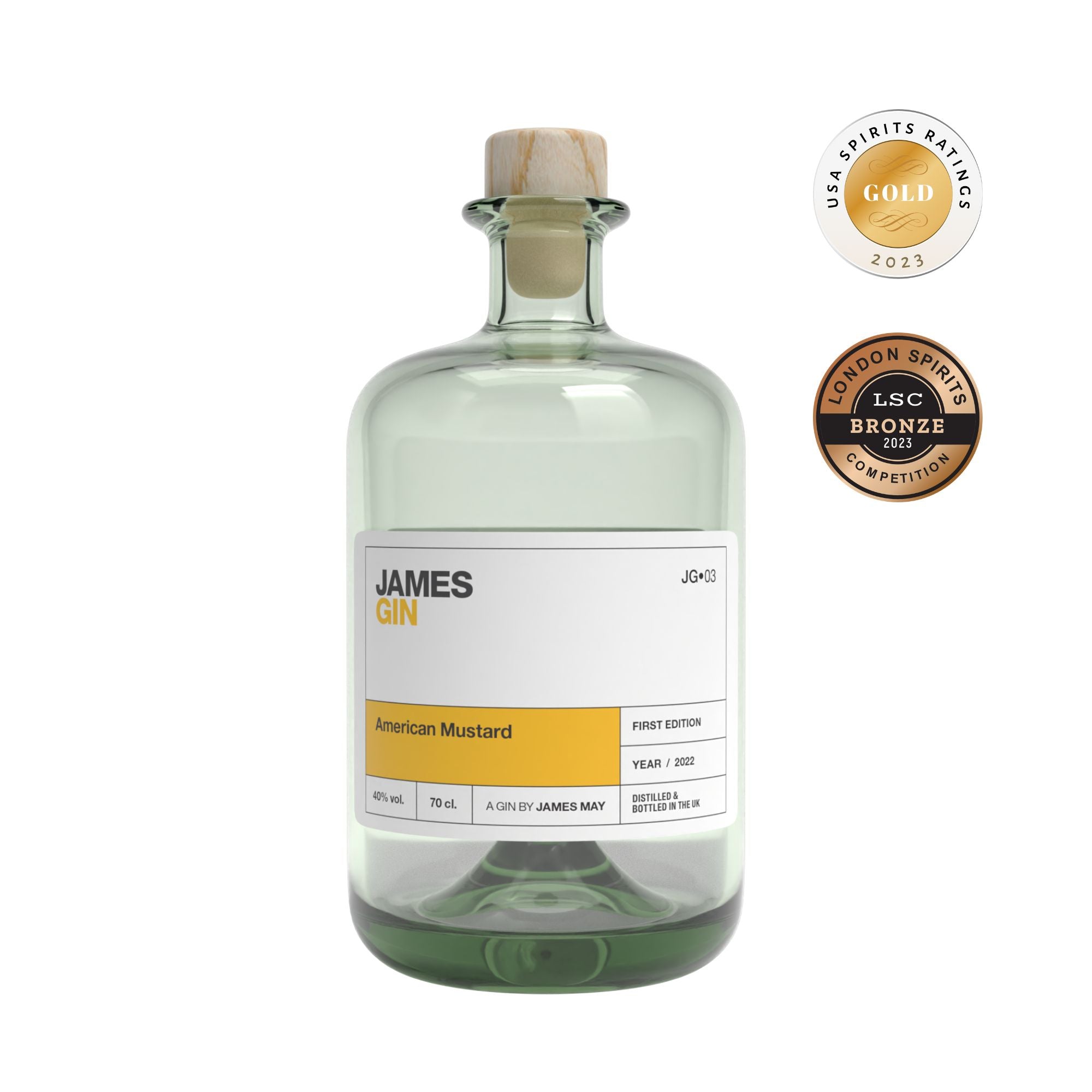
The Inspiration
This was my litmus test from James gave me a bottle of squeezy mustard with the challenge of creating something.
With mustard front and central, I had to understand how mustard seed could be used within alcohol.
As the mustard provided warmth and was light on the tongue, I decided that it needed to be paired with another botanical that no was using, gherkin!
Recipes with American Mustard
View all recipesAmerican Mustard
The Marga-Gin-TaAmerican Mustard
Christmas ThreeAmerican Mustard

The boring stuff
If you’d like to sell James Gin in your shop, pub, off-license, airline, massive global retail environment, we’d be delighted to talk. Click here, fill in the form, sit back with a G&T and we’ll be in touch. Cheers.
Company Name: Asian Parsnip Ltd
Company Registration No: 13370389
Email: info@jamesgin.com
Physical address:
Asian Parsnip Ltd
Freshford House
Redcliffe Way
Bristol
BS1 6NL
United Kingdom
VAT number: GB 384393758
© 2024, JamesGin Global.

